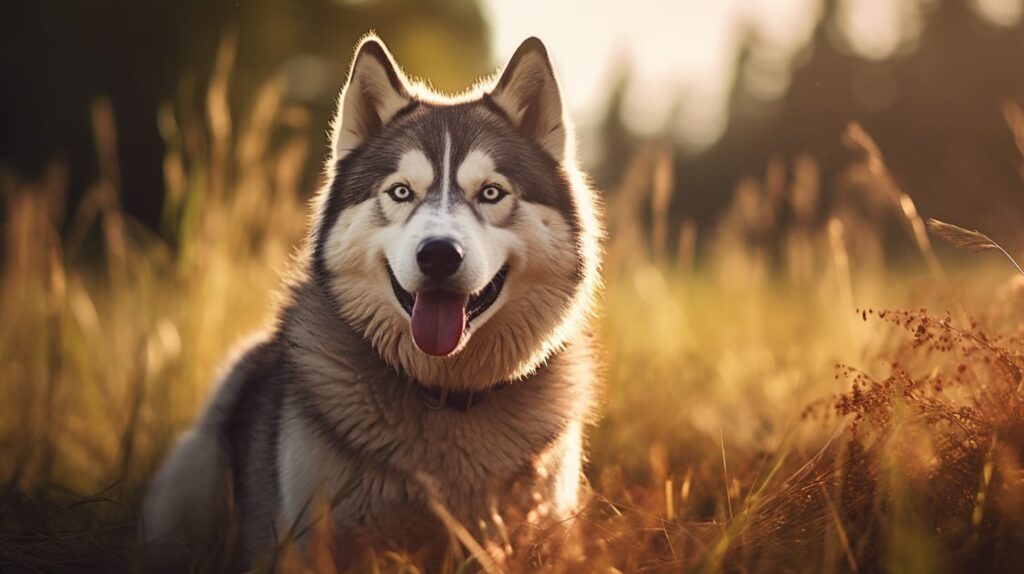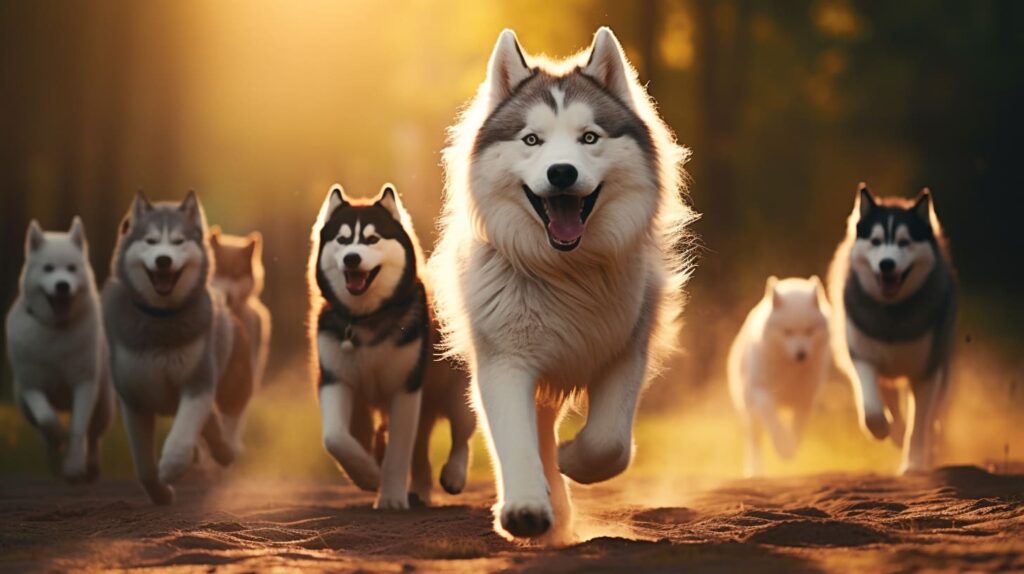Welcome to the world of Huskies, where every day is an adventure, and every bark tells a story! If you’re the proud parent of a Husky, you know these fluffy bundles of energy are more than pretty faces with piercing blue eyes. They’re intelligent, playful, and have a personality as big as their howl. But here’s the deal: socializing your Husky can sometimes feel like teaching a snowflake not to melt. It is challenging, yes, but oh-so-rewarding!
Socialization is more than just a buzzword in the dog world; it’s the cornerstone of a well-adjusted, happy Husky. It’s about exposing your furry friend to different people, dogs, sights, sounds, and experiences in a positive way. Think of it as their passport to becoming confident, sociable pooches.
But let’s face it, it’s not always a walk in the park (even if it involves lots of park walks). Some Huskies might be shy wallflowers, while others are party animals who just don’t know their strength. The key is understanding that each Husky is unique, and what works for one might not work for another. It’s about finding that sweet spot where your Husky feels safe but is still gently nudged out of their comfort zone.
So, whether you’re introducing your Husky pup to the world for the first time or helping an older Husky become a social butterfly, this guide is your go-to. We’re here to wag through this journey together. Let’s turn those socialization challenges into triumphs, one paw at a time!
Table of Contents
Understanding Husky Temperament
Huskies are renowned for their distinctive personalities, which can both charm and challenge their owners. Let’s dive into what makes these furry friends tick and how their temperament influences their social behavior.
Energetic and Playful
- High Energy Levels: Huskies are energy powerhouses, originally bred for pulling sleds over long distances. This boundless energy means they require regular, vigorous exercise.
- Playfulness: Their playful nature is a joy to behold, but it can be overwhelming for other pets or people not used to such enthusiastic displays of affection.
Intelligent and Independent
- Smart Cookies: Intelligence is a Husky hallmark. They learn quickly but can also be cunning, often finding mischievous ways to entertain themselves.
- Independent Streak: Huskies have a strong independent streak, sometimes mistaken for stubbornness. This trait can make them seem aloof, especially in social settings.
Strong Pack Mentality
- Pack-Oriented: As pack animals, Huskies thrive in company, be it human or canine. They often look to their human family as their pack and seek regular interaction.
- Separation Anxiety: This pack mentality can sometimes lead to separation anxiety if left alone for extended periods, impacting their social behavior.
Vocal and Expressive
- Talkative Nature: Unlike many breeds, Huskies are known for being vocal, using howls and moans to communicate. This can be misinterpreted by people and other dogs not familiar with the breed.
- Body Language: Their expressive nature extends to their body language. Understanding Husky-specific cues is crucial for successful social interactions.
By understanding these unique traits, Husky owners can better tailor their socialization strategies to suit their pet’s personality. In the following sections, we’ll explore how to harness these traits to overcome socialization challenges.
The Early Bird Gets the Worm: The Importance of Early Socialization
Socializing your Husky puppy is a bit like teaching them the doggy version of manners. The earlier you start, the smoother the process. Puppies have a golden window of socialization that typically closes by about 12 to 14 weeks of age. During this time, they’re super receptive to new experiences, a bit like sponges soaking up everything around them!
Start with a Plan
- Create a Socialization Checklist: Jot down a variety of experiences you want your puppy to get used to. This list might include meeting different types of people, encountering other animals, hearing various sounds, and exploring new environments.
- Go at a Puppy Pace: Remember, it’s not a race. Gradually introduce these experiences to avoid overwhelming your little furball.
People and Places
- Introduce a Variety of People: Let your Husky pup meet people of all ages and appearances. Think hats, beards, uniforms – the whole human spectrum!
- Visit Dog-Friendly Locations: Take your Husky to places where they can encounter new sights, sounds, and smells, like pet stores or dog-friendly parks.
Safe Animal Interactions
- Puppy Playdates: Arrange meetings with other vaccinated and friendly puppies or adult dogs. This helps your Husky learn the ropes of canine social etiquette.
- Other Pets at Home: If you have other pets, supervise their first interactions with your Husky puppy in a controlled environment.
Handling and Grooming
- Regular Handling: Get your Husky used to being touched. Gently handle their paws, ears, and tail to prepare them for grooming and vet visits.
- Brushing and Bathing: Start regular grooming routines early. This not only keeps your Husky looking sharp but also helps them get comfortable with being handled.
Exposure to Different Environments
- Diverse Scenarios: Expose your Husky to different settings – busy streets, calm parks, car rides, and even public transport if possible.
- Desensitization to Sounds: Gradually introduce your puppy to various sounds like traffic, vacuum cleaners, and other household noises.
Socializing your Husky during this key developmental stage lays a solid foundation for a well-adjusted adult dog. It’s about creating a well-rounded canine citizen who’s comfortable in their furry skin no matter where they are or who they’re with. So, let the socialization adventure begin!
Addressing Socialization Challenges in Adult Huskies
Adult Huskies, especially those who may have missed out on early socialization opportunities, can still learn to be social butterflies. It just takes a bit more patience and understanding. Here’s how you can help your adult Husky become more comfortable in social settings.

Overcoming Missed Early Socialization
- Start Slow: Begin with short, controlled exposures to new situations and gradually increase the duration as your Husky becomes more comfortable.
- Safe Space: Create a safe and calm environment at home where your Husky can retreat if they feel overwhelmed.
- Observation First: Let your Husky observe social situations from a distance before participating, allowing them to get accustomed to new sights and sounds at their own pace.
Tackling Specific Issues
Fear and Anxiety
- Positive Reinforcement: Use treats and praise to reward calm behavior in new situations.
- Desensitization: Gradually expose your Husky to their fears in a controlled manner, slowly building their confidence.
- Avoid Overwhelming Them: Recognize the signs of fear and anxiety and avoid pushing your Husky too far too fast.
Aggression
- Understand the Triggers: Identify what triggers your Husky’s aggression, whether it’s specific situations, animals, or people.
- Controlled Exposure: Introduce your Husky to their triggers in a controlled environment and at a safe distance.
- Professional Help: Consider enlisting a professional dog trainer or behaviorist for aggressive behaviors.
Overexcitement
- Teach Calm Behavior: Train your Husky to sit or lie down calmly in various situations.
- Exercise: Ensure your Husky gets ample physical exercise to help manage their energy levels.
- Reward Calmness: Consistently reward your Husky when they remain calm in exciting situations.
Patience and Consistency
- Regular Practice: Regularly expose your Husky to various social situations.
- Stay Calm and Positive: Your attitude greatly influences your Husky’s behavior. Remain calm and patient.
- Consistent Approach: Use the same commands and rewards to create a consistent learning environment.
Creating Positive Social Experiences
Socialization isn’t just about exposure; it’s about creating positive associations with new experiences. For your Husky, the world is a giant playground, but they need to learn how to play nicely and safely in it.
Techniques for Positive Associations
To make social interactions enjoyable and stress-free for your Husky, use these techniques:
- Treats and Praise: Reward your Husky with their favorite treats or heaps of praise when they exhibit calm and friendly behavior during social encounters. This positive reinforcement encourages them to repeat the behavior.
- Play and Fun Activities: Associate new experiences with fun activities. If your Husky meets a new dog, pair the introduction with a play session. This creates a link in their mind between socializing and having a good time.
- Gradual Exposure: Start with short, controlled interactions and gradually increase the duration and complexity as your Husky gets more comfortable. This could mean brief meetings with new people or dogs initially, then slowly working up to more extended playdates or visits.
Consistent and Gentle Reinforcement
Consistency is key in reinforcing positive social behavior:
- Regular Practice: Regularly expose your Husky to different social situations. The more they practice, the more comfortable they will become.
- Patience and Persistence: Some Huskies may take longer to warm up to new experiences. Be patient and persistent, and never force your Husky into an overwhelming situation.
- Positive Reinforcement Techniques: Use techniques like clicker training or verbal cues to reinforce good behavior. Consistent use of these techniques helps your Husky understand what is expected of them.
Creating positive social experiences is a crucial step in overcoming socialization challenges with your Husky. By using these techniques, you can help your furry friend become a confident and well-adjusted companion.
The Role of Training in Socialization
Training is not just about teaching your Husky to sit or stay; it’s a powerful tool in socializing them too. Well-trained Huskies are more likely to be calm and confident in social settings, making interactions smoother for everyone involved.
Basic Training Commands
Start with the basics. Commands like sit, stay, come, and leave it are crucial. They give you control in social situations, helping you manage your Husky’s behavior effectively.
- Sit: This command is essential for calming your Husky in exciting social environments.
- Stay: Use this to keep your Husky in place when new people or dogs approach.
- Come: This recall command is a lifesaver, literally. It ensures your Husky returns to you in potentially risky situations.
- Leave it: Perfect for preventing your Husky from picking up or interacting with unwanted items or beings.
Building Confidence Through Obedience
Obedience training goes beyond commands; it builds a bond between you and your Husky. This bond fosters trust, and a trusting Husky is more likely to respond positively in social settings.
- Consistency Is Key: Regular training sessions reinforce desired behaviors.
- Positive Reinforcement: Reward your Husky with treats, praise, or play to make training a positive experience.
- Patience Pays Off: Huskies can be independent thinkers. Be patient and persistent with training.
Improving Social Behavior
Training helps in mitigating issues like jumping on people or overly enthusiastic greetings.
- Polite Greetings: Train your Husky to sit calmly when meeting new people.
- Controlled Walks: Teach your Husky to walk nicely on a leash, reducing stress in busy social environments.
Safe and Successful Dog-to-Dog Interactions
Preparing for the Meet and Greet
Before introducing your Husky to another dog, ensure both dogs are on leashes and in a neutral area. This prevents territorial behavior. Start with short, controlled interactions, gradually increasing the duration as both dogs become comfortable.
Reading Dog Body Language
Understanding canine body language is crucial. Watch for relaxed body postures, playful bows, and wagging tails as signs of positive interaction. Conversely, raised hackles, stiff tails, or growling indicate discomfort or aggression. Interrupt and separate the dogs if you notice these signs.
The Art of the Sniff
Allow the dogs to sniff each other — this is their way of saying “hello.” Keep the leashes loose to avoid tension. If either dog seems overly anxious or aggressive, calmly separate them and try again later.
Post-Meeting Rewards
After a successful meeting, reward both dogs with treats and praise. This reinforces the idea that good things happen when they interact nicely with other dogs.
Gradually Increasing Social Exposure
Once your Husky is comfortable in one-on-one settings, gradually introduce them to larger groups of dogs. Always monitor interactions and be ready to step in if needed.
Overcoming Human Socialization Hurdles
Introducing Your Husky to New People
Huskies, with their striking appearance and friendly nature, often attract attention. However, not all Huskies naturally take to new people. When introducing your Husky to someone new, start in a calm and familiar environment. Let your Husky approach them at their own pace, and encourage the person to avoid direct eye contact or sudden movements, as these can be intimidating. A little patience goes a long way, and treats from the new person can be a great icebreaker!
Managing Different Environments
Huskies can be quite the explorers, but new environments can sometimes be overwhelming. Gradually expose your Husky to different settings:
- Busy Streets: Start by observing from a distance where your Husky can see and hear the bustle without being in the midst of it. Gradually move closer as they become more comfortable.
- Dog Parks: These can be overwhelming, so initially try going during off-peak hours. Keep initial visits short and sweet.
- Public Spaces: Places like outdoor cafes or pet-friendly stores are great for practicing calm behavior in the presence of strangers.
Tips for a Positive Experience
- Consistency is Key: Regular, positive interactions build trust and confidence.
- Read Their Signals: Learn to understand your Husky’s body language. If they seem uncomfortable, give them space and try again later.
- Reward Good Behavior: Positive reinforcement with treats and praise encourages your Husky to repeat good behavior in social settings.
ChatGPT
Absolutely, here’s Section 9 of the article in Markdown format:
Seeking Professional Help When Needed
Sometimes, the path to a well-socialized Husky might have a few more twists and turns than expected. It’s completely okay to seek a helping hand—or paw—in these situations. Professional help can be a game-changer, transforming a bumpy journey into a smooth sled ride.
When to Consider Professional Help
- Persistent Issues: If your Husky continues to display fear, aggression, or extreme shyness despite your best efforts, it might be time to call in the pros.
- Safety Concerns: If socialization challenges pose a safety risk to your Husky, yourself, or others, professional intervention is crucial.
- Feeling Overwhelmed: Sometimes, the guidance and reassurance from a professional can provide peace of mind and a clear plan forward.
The Benefits of Professional Training
- Expertise and Experience: Professional trainers have a wealth of knowledge and can offer tailored strategies that are most effective for your Husky’s unique personality.
- Structured Environment: Training classes provide a controlled environment for safe socialization with other dogs and people.
- Building Confidence: Both you and your Husky can gain confidence from structured lessons that address specific socialization challenges.
Finding the Right Professional
- Research: Look for trainers or behaviorists with experience in dealing with similar issues and, ideally, with Huskies.
- Certifications: Check for certifications or qualifications that ensure they use up-to-date, humane training methods.
- Recommendations: Ask fellow Husky owners or your vet for recommendations to find trusted professionals.
Seeking help is not a step back but a giant leap forward in ensuring your Husky becomes the sociable, happy dog they are meant to be. Remember, it’s all about making the journey together, one paw at a time!
The Last Bark
Patience and Consistency: The Key to Success
Remember, every Husky is a unique snowflake, and their journey to becoming a social butterfly can be as varied as their stunning coat patterns. Patience is your best friend in this adventure. Sometimes progress might seem as slow as a sled without snow, but every small step is a giant leap in your Husky’s socialization.
The Reward of a Well-Socialized Husky
Imagine the joy of seeing your Husky confidently navigating a park, tail wagging and ears perked up in curiosity, rather than fear. That’s the dream, right? A well-socialized Husky isn’t just a happy Husky; it’s a happy you, too! It means stress-free walks, enjoyable trips, and the proud feeling of having a furry ambassador of good vibes.
The Journey is as Rewarding as the Destination
Don’t forget to enjoy the ride! Each new person, dog, and experience is a chapter in your Husky’s life story. Celebrate the victories, learn from the setbacks, and keep trekking forward. After all, isn’t the bond you’re building the most beautiful part of it all?
Additional Resources
Books on Dog Behavior and Training
- The Other End of the Leash: Why We Do What We Do Around Dogs by Patricia B. McConnell
- A fantastic read that helps understand the canine perspective and improve human-dog interactions.
- How to Raise the Perfect Dog: Through Puppyhood and Beyond by Cesar Millan
- Cesar Millan shares his expertise on raising a happy, well-behaved dog.
Helpful Websites
- The American Kennel Club (AKC) – Training Resources
- Offers a plethora of training tips and articles on dog behavior.
- Husky Owners – The Siberian Husky Forum
- A community forum where Husky owners share advice and experiences.
Local Training Centers
- Pawsitive Dog Training
- Offers group classes and individual sessions focused on socialization and obedience. Find a local center here.
- Canine Good Citizen Classes
- Conducted by AKC, these classes are great for teaching social skills. Locate classes near you.
Online Courses
- Udemy – Dog Training Courses
- Features a range of online courses covering various aspects of dog training, including socialization.
- Fenzi Dog Sports Academy
- Offers online courses focused on positive reinforcement training methods.






